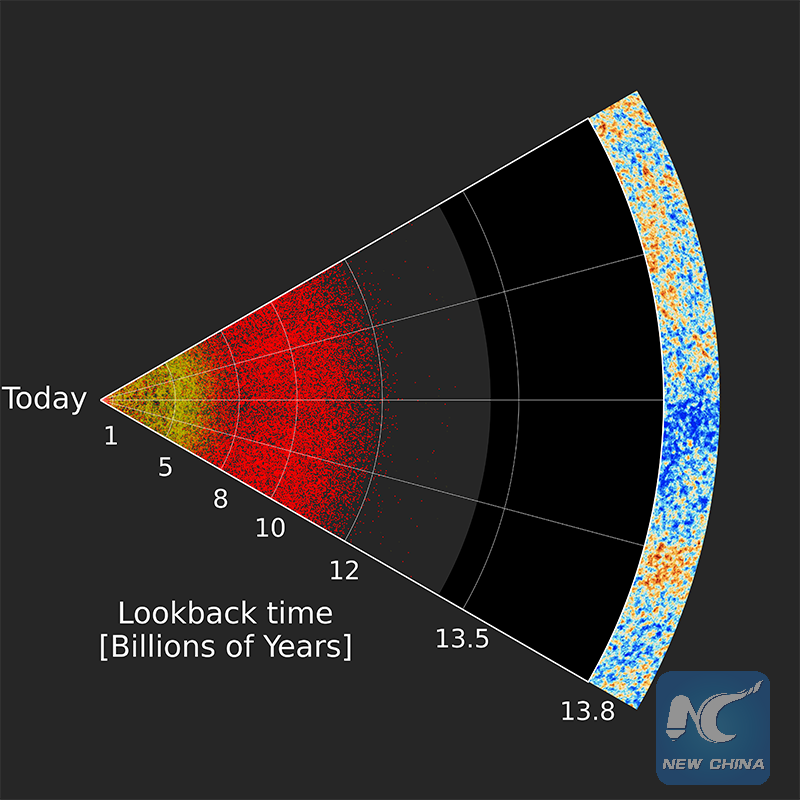
A slice through largest-ever three-dimensional map of the Universe. Earth is at the left, and distances to galaxies and quasars are labelled by the lookback time to the objects (lookback time means how long the light from an object has been traveling to reach us here on Earth). The locations of quasars (galaxies with supermassive black holes) are shown by the red dots, and nearer galaxies mapped by SDSS are also shown (yellow).
(Image Credit: Anand Raichoor (École polytechnique fédérale de Lausanne, Switzerland) and the SDSS collaboration)
LOS ANGELES, May 28 (Xinhua) -- Based entirely on the positions of quasars, an international collaboration of astronomers with the Sloan Digital Sky Survey (SDSS) have created the first map of the large-scale structure of the Universe. It could also help improve our understanding of dark energy.
"To unveil the mystery of the cosmic acceleration, the astronomers have been trying to map the Universe from now to the remote past. The Chinese astronomers, especially those from National Astronomical Observatories of Chinese Academy of Sciences (NAOC) working on observational and theoretical cosmology, have been playing key roles in the large international collaborations of the eBOSS galaxy survey," Xue Suijian, professor and deputy director of the National Astronomical Observatories of China (NAOC) under Chinese Academy of Sciences, told Xinhua on Sunday.
Quasars are the incredibly bright and distant points of light powered by supermassive black holes. As matter and energy fall into a quasar's black hole, they heat up to incredible temperatures and begin to glow.
It is this bright glow that is detected by a dedicated 2.5-meter telescope here on Earth. The telescope's observations gave the scientists the quasars'distances, which they used to create a three-dimensional map of where the quasars are.
"These quasars are so far away that their light left them when the Universe was between three and seven billion years old, long before the Earth even existed," said Gongbo Zhao from the National Astronomical Observatories of Chinese Academy of Sciences, the study's other co-leader.
To make their map, the international research team used the Sloan Foundation Telescope to observe an unprecedented number of quasars. During the first two years of the SDSS's Extended Baryon Oscillation Spectroscopic Survey (eBOSS), astronomers measured accurate three-dimensional positions for more than 147,000 quasars, according to SDSS.
And to use the map to understand the expansion history of the Universe, the astronomers had to go a step further, using measurements of a phenomena known as baryon acoustic oscillations (BAOs), which are the present-day imprint of sound waves which travelled through the early Universe, when it was much hotter and denser than the Universe we see today.
But when the Universe was 380,000 years old, conditions changed suddenly and the sound waves became "frozen" in place. These frozen waves are left imprinted in the three-dimensional structure of the Universe we see today.
The results of the new study also confirm the standard model of cosmology that researchers have built over the last twenty years. In this standard model, the Universe follows the predictions of Einstein's General Theory of Relativity - but includes components whose effects we can measure, but whose causes we do not understand, according to the study.
There is still work to be done however, and the eBOSS experiment continues using the Sloan Telescope at Apache Point Observatory in New Mexico, USA, in order to observe even more quasars and increase the size of any future maps.
"Besides eBOSS, the Dark Energy Spectroscopic Instrument (DESI), which is a larger galaxy survey mapping the Universe using remote astronomical objects up to 10 billion light years from us, will start observations in 2018, and Chinese astronomers will continue contributing great efforts," Xue said.

